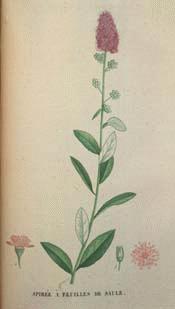
Botanical.com Home Page

|
Willowleaf Meadowsweet
(Spiraea salicifolia)
Click on graphic for larger image
|
Meadowsweet
Botanical: Spiraea Ulmaria (LINN.)
Family: N.O. Rosaceae
---Synonyms---Meadsweet. Dolloff. Queen of the Meadow. Bridewort. Lady of the Meadow.
---Part Used---Herb.
---Description---The fragrant Meadowsweet is one of the best known wild flowers, decking our meadows and moist banks with its fernlike foliage and tufts of delicate, graceful, creamy-white flowers, which are in blossom from June to almost September. The leaves are dark green on the upper side and whitish and downy underneath, much divided, being interruptedly pinnate, having a few large serrate leaflets and small intermediate ones; the terminal leaflets are large, 1 to 3 inches long and three to five lobed. The stems are 2 to 4 feet high, erect and furrowed, sometimes purple. The flowers are small, clustered close together in handsome irregularly-branched cymes, and have a very strong, sweet smell. The whole herb possesses a pleasant taste and flavour, the green parts partaking of the aromatic character of the flowers.
- A peculiarity of this flower is that the scent of the leaves is quite different from that of the flowers. The latter possess an almondlike fragrance, it is one of the fragrant herbs used to strew the floors of chambers. In allusion to this use, Gerard writes:
- 'The leaves and floures of Meadowsweet farre excelle all other strowing herbs for to decke up houses, to strawe in chambers, halls and banqueting-houses in the summer-time, for the smell thereof makes the heart merrie and joyful and delighteth the senses.'
Meadowsweet, water-mint, and vervain were three herbs held most sacred by the Druids.
It is one of the fifty ingredients in a drink called 'Save,' mentioned in Chaucer's Knight's Tale, in the fourteenth century being called Medwort, or Meadwort, i.e. the mead or honey-wine herb, and the flowers were often put into wine and beer. It is still incorporated in many herb beers.
The name Ulmaria is given in allusion to the resemblance of its leaves to those of the Elm (Ulmus), being much wrinkled on the upper side.
- Gerard says:
- 'It is reported that the floures boiled in wine and drunke do take away the fits of a quartaine ague and make the heart merrie. The distilled water of the floures dropped into the eies taketh away the burning and itching thereof and cleareth the sight.'
- Culpepper says much the same and also:
- 'The leaves, when they are full grown, being laid on the skin will, in a short time, raise blisters thereon, as Tragus saith.' He also states that for acquiring the 'merry heart' (which Gerard mentions) 'some use the flowers and some the leaves.' He tells us that 'a leave hereof put into a cup of claret wine gives also a fine relish to it.'
---Medicinal Action and Uses---Aromatic, astringent, diuretic, and sub-tonic. It is a valuable medicine in diarrhoea, imparting to the bowels some degree of nourishment, as well as of astringency. It is also considered of some service as a corrector of the stomach, and not without some power as an alterative, and is frequently used in affections of the blood. It is a good remedy in strangury, dropsy, etc., and almost a specific in children's diarrhoea.
An infusion of 1 OZ. of the dried herb to a pint of water is the usual mode of administration, in wineglassful doses. Sweetened with honey, it forms a very pleasant diet-drink, or beverage both for invalids and ordinary use.
The herb is collected in July, when in flower.
An infusion of the fresh tops produces perspiration, and a decoction of the root, in white wine, was formerly considered a specific in fevers.
Meadowsweet is visited by bees for the pollen.
[Top]
---Dosage---Fluid extract, 1/2 to 1 drachm.
---Other Species---
Another member of the Spiraea is Spircea Filipendula (Dropwort). A herb about a foot high, with short rhizome and nodulose rootlets; leaves interruptedly pinnate, leaflets cut into narrow serrated segments; flowers in crowded, erect, compound cymes, pink externally in bud; when open, white and scentless. Dry pastures on a limestone (or chalky) soil. Distinguished from S. Ulmaria by its elegantly cut foliage, pink buds, and whiter scentless blossoms. A double-flowered variety is common in gardens. Flowering time - June, July. Perennial.
- Culpepper speaks of Filipendula, or Dropwort, as being a good remedy for kidneyaffections, by 'taking the roots in powder or a decoction of them in white wine, with a little honey.' He adds that it:
- 'is also very effectual for all the diseases of the lungs, as shortness of breath, wheezing, hoarseness of the throat; and to expectorate tough phlegm, or any other parts thereabout.'

|
Willowleaf Meadowsweet
(Spiraea salicifolia)
Click on graphic for larger image
|
WILLOW-LEAVED SPIRÆA (S. salyciflora), a shrub with simple ex-stipulate leaves and spike-like clusters of rose-coloured flowers, grows in moist woods in the north and in Wales; but it is not indigenous. It flowers in July and August. Perennial.
There are several foreign species of Spiraea, one from Japan being a beautiful shrub with pure white flowers, and leaves like those of the plum, hence its name, S. prunifolia.
There is another from Nepaul, S. bella, with rose-coloured flowers growing in lateral and terminal corymbs; another from Canada, S. tomentosa, with cottony leaves and pyramidal panicles of rose-coloured flowers; and S. Fortunei from China, with ovate, smooth, toothed leaves often tinged with purple, and rose-coloured flowers.
See:
HARDHACK
INDIAN PHYSIC
[Top]
Common Name Index
A MODERN HERBAL Home Page
Bear in mind "A Modern Herbal" was written with the conventional wisdom of the early 1900's. This should be taken into account as some of the information may now be considered inaccurate, or not in accordance with modern medicine.
© Copyright Protected 1995-2025 Botanical.com
|

